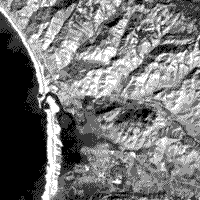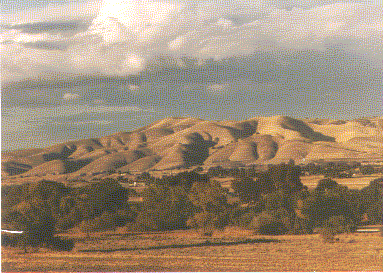Ground and Aerial Photographs of the Morro Bay Area¶
Contents
This page is a gallery of mostly ground photos taken by the writer (NMS) during two visits to Morro Bay, in 1995 and again in 1999. These provide a means for the viewer to gain a feel for what the towns and natural features in this area actually look like, so as to better correlate the TM subscene�s contents with their counterparts as these appear on the surface. An aerial oblique photo covers much of the same area and should serve as the reference in comparing scene characteristics between the TM vertical view and the more familiar near surface manifestations.
Ground and Aerial Photographs of the Morro Bay Area¶
` <Image1_3.gif>`__(Credit: Golden State Aerial Surveys, San Luis Obispo, California)
` <>`__1-3: Glancing back and forth between these oblique photos and the Band 3 image repeated below, try to locate in the Landsat scene whatever ground features you note/identify in the aerial oblique photo. Also, see if you can find in the Landsat image the approximate place where the above land photo was taken. `ANSWER <Sect1_zanswer.html#1-3>`__
Lets look at some of these features more closely, as photographed by the writer during two visits, in 1994 and 1999. The town of Morro Bay is a popular tourist attraction streaming with visitors much of the year. The Main street area is typical of many smaller California towns located along the coast.
Its waterfront, called the Embarcadero, is lined with shops, restaurants, and boat moorings, as seen here:
Note the three smokestacks of the powerhouse, notable in the aerial oblique photo but hard to pick it in the Landsat image, in the background. Behind this plant are five oil storage tanks, conspicuous in both the aerial photo and the Landsat imagery; as seen from the ground:
One surface feature stands out in both the aerial photo and the panoramic ground scene: Morro Rock, a great erosional monolith made of silicic volcanic rock (part of a chain known as the Seven Sisters; other volcanic necks [central vents] also appear in this scene) that reaches a height of 175 m. (574 ft) above the Pacific.
Technically, this is a sea stack, an outlier of rock that became detached from the mainland as waves cut away at the shoreline. Here, we see a narrow deposit of sand, caused by deposition in shallow water. This sand bridge connects the stack with the mainland, producing what is known as a “spit”.
Just to its north is the public beach against which waves break in a pounding surf; this picture was taken as the ubiquitous summer fog was beginning to clear for the day.
Morro Bay itself is formed from a long barrier island tied to the south end and open as an inlet near Morro Rock. Exposed sand dunes occupy much of the surface but patches of low saltwater vegetation are scattered over it:
Extending into the bay near its southeast end is a delta formed by a small river. This delta supports estuarine and riverine vegetation as depicted in this east-looking view:
The southern side of the hills running eastward and perpendicular to the ocean, with several conspicuous volcanic peaks (other Seven Sisters), but vegetation-covered, appears in this view taken from a point SE of Morro Bay town.
On the north side of these hills, along Highway 1, the flat valley is given to agriculture. Seen in this photo are fields of the main crop in the area - snow peas:
More widespread farming takes place in the valley traversed by Highway 41. The brown area noted in the aerial oblique photo is largely made up of Avocado trees, as seen here:
|North of Morro Bay, looking southwest into valley with avocado trees as local crop; low hills in the mid ground and scrub brush in foreground |
Other cultivated acreage include snow peas and grapes (wine-producing), evident in this photo which also shows the low grass-covered hills that make up much of the rolling topography inland from the coastline:
The high coastal mountains to the east of the Morro Bay-Baywood-Los Osos developments make up the Santa Lucia Range, along which we find California Live Oaks and other trees and foliage that comprise the northernmost extension of Los Padres National Forest in south-central California. This high country (elevations above 700 meters [2200 ft]) as seen from the east side of Morro Bay is shown next, along with the brown grassy foothills, and a stubble field in the foreground.
Denser forests extend from the higher elevations (about 260 m or 850 ft, in the Landsat subscene) into the lowlands along streams. The next view is a typical example.
The hallmark of much of the hillsides in both the Coast Range and Sierra Nevada foothills is the natural grasses covering which reach their full greenery during the rainy season from October through April. By May, these grasslands assume a pleasing golden yellow-brown color that persists through Summer into early Fall. This brownish background contrasts with the deep greens of the oaks and evergreens exemplified in the next photograph.





